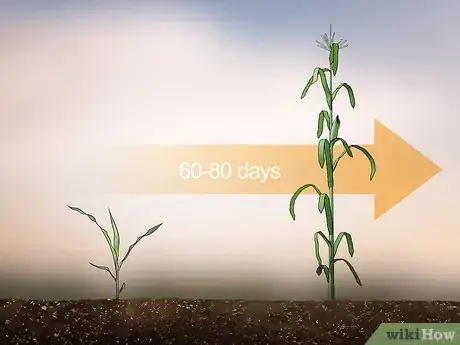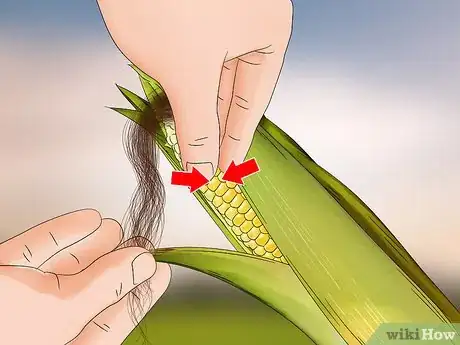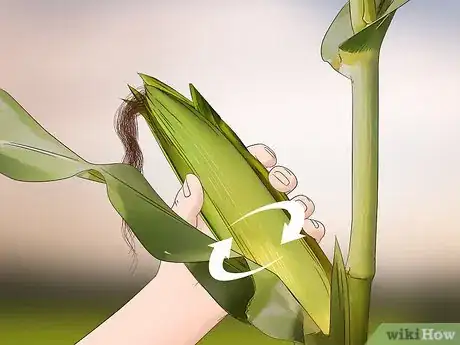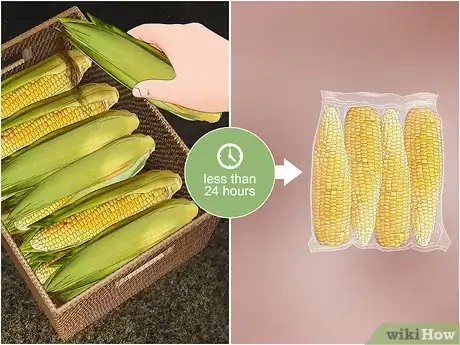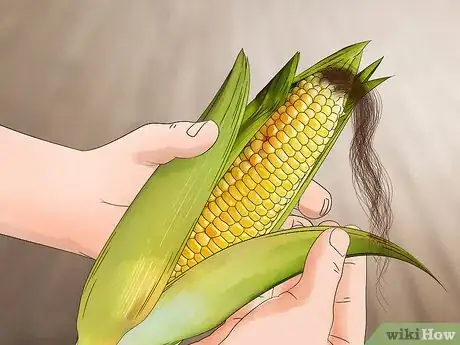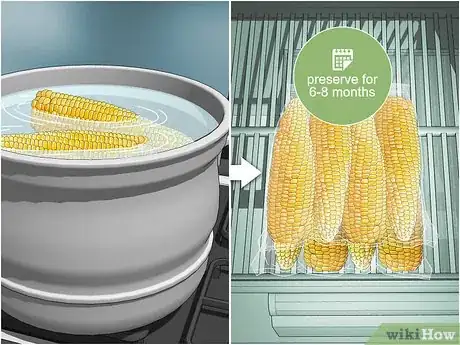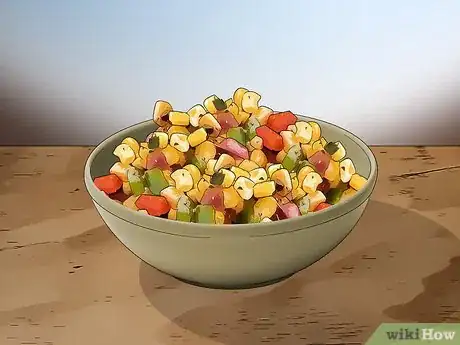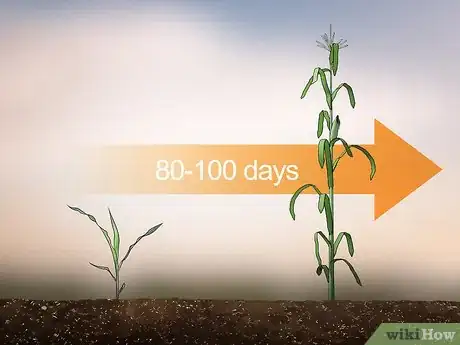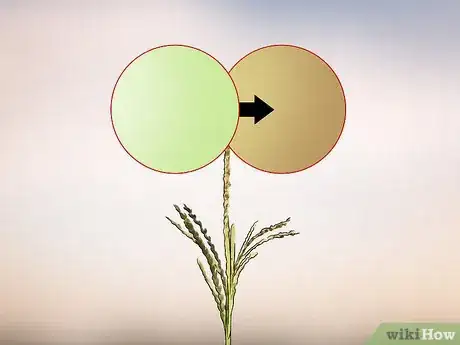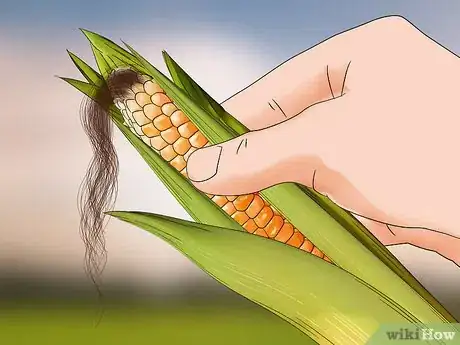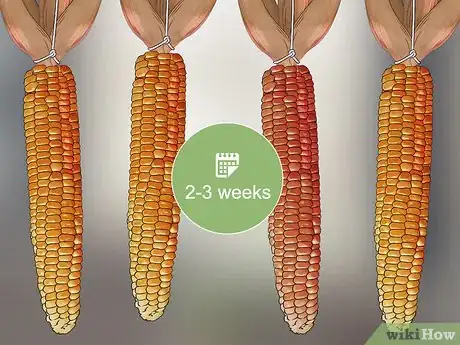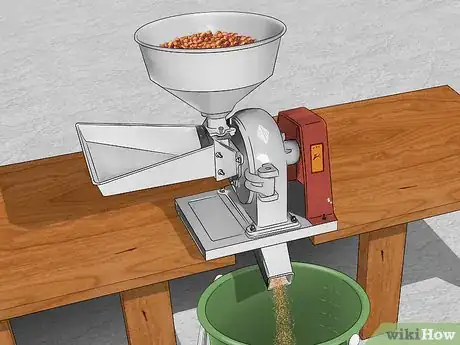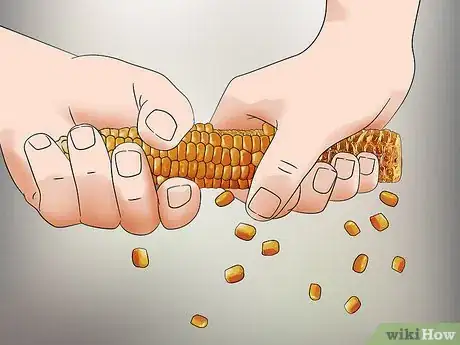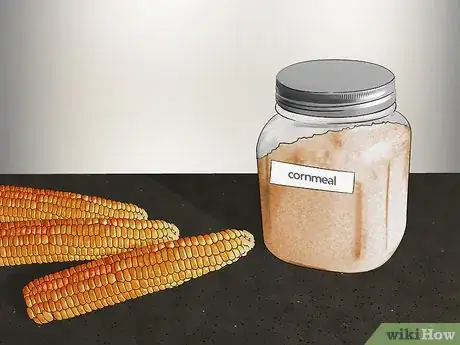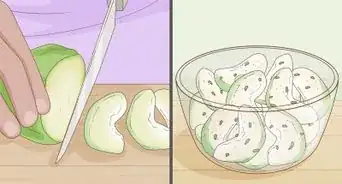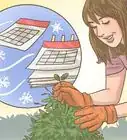This article was co-authored by wikiHow Staff. Our trained team of editors and researchers validate articles for accuracy and comprehensiveness. wikiHow's Content Management Team carefully monitors the work from our editorial staff to ensure that each article is backed by trusted research and meets our high quality standards.
There are 13 references cited in this article, which can be found at the bottom of the page.
wikiHow marks an article as reader-approved once it receives enough positive feedback. In this case, 92% of readers who voted found the article helpful, earning it our reader-approved status.
This article has been viewed 88,640 times.
Learn more...
After you've planted and grown corn in your garden, the next step is harvesting. Harvesting corn is quick and simple after you've noticed its tassels turn brown and corn kernels mature. Pick and husk your corn using the proper technique, then store your corn by freezing, canning, or drying it. Once you've harvested your corn, you'll have plenty to use for baking or decoration!
Steps
Harvesting Sweet Corn
-
1Harvest sweet corn 60-80 days after planting it. On average, sweet corn takes 60-80 days to mature. Make a note on your calendar to check for harvesting signs at around 60 days after planting.[1]
- Corn harvests quickest in hot weather, especially temperatures over 90 °F (32 °C).[2]
-
2Harvest the corn when the tassels turn brown. The corn tassel is the pollen-releasing stem on the tops of corn plants. As your corn matures, its tassels should turn from green to brown. Avoid harvesting the corn until the tassels' green color has disappeared completely.[3]
- The tassels should turn brown about 3 weeks after the plant flowers.[4]
Advertisement -
3Squeeze sweet corn kernels to check for a milky fluid. Pull back the corn silk and squeeze a kernel between your finger and thumb. If the kernel releases a milky fluid, your plant is ready for harvest.[5]
- If your corn kernels are not mature, they will be firm and won't release a milky fluid. If that's the case, smooth the silk and husk back over unripe kernels. Your corn will still mature without any problems.[6]
-
4Twist each corn ear off of its stalk. Hold the stalk in your non-dominant hand to steady it while you harvest. With your dominant hand, grab a corn ear and twist it to the side. Pull the ear down and yank hard, then put your freshly-picked corn in a bucket or pile.[7]
- Pulling on the cornstalk without twisting can kill the plant.[8]
-
5Prepare sweet corn quickly to prevent the flavor from deteriorating. When left in room-temperature conditions for 24 hours, sweet corn loses 50% of its sugar. Store or prepare sweet corn the same day that you pick it for a fresher taste.[9]
- You can store sweet corn in the fridge for 2-4 days by wrapping unopened husks in damp paper towels.[10]
-
6Remove the corn husk and silk. Pull on the husk leaves one at a time until you have completely exposed the small silky hairs covering the kernels. Pick off the silk one hair at a time or use an old toothbrush to rub them off.[11]
- Microwaving the corn can make it easier to husk. Set the microwave power to high and heat the unhusked corn for 2 minutes.
- Put the silk and husks in a large container or trash bag to make cleanup easier.
-
7Freeze sweet corn to preserve it for 6-8 months. Blanch your corn in boiling water, then put your corn cobs in an airtight container and store it in the freezer. Freeze your corn for up to 6-8 months to have fresh-tasting corn no matter the season.[12]
- You can also cut the kernels off of the cob with a knife before freezing for compact storage.
-
8Can sweet corn to preserve it for up to 5 years. If you don't plan on cooking your corn 2-4 days after harvesting, blanch your corn and remove the kernels with a sharp knife. Store the kernels in a jar and place them in a pressure canner to seal the jar.[13]
- Canned corn tends to last longer than frozen corn at around 3-5 years.[14]
-
9Cook sweet corn as a side dish if you want to eat it right away. Sweet corn makes a healthy, delicious side for most meals. You can cook fresh or preserved corn by boiling, microwaving, baking, grilling, or steaming it.[15]
- If you do not want to store your sweet corn, cook it immediately after harvesting.[16]
Harvesting Flint Corn or Popcorn
-
1Plan to harvest flint corn 80-100 days after planting it. Unlike sweet corn, flint corn takes between 80-100 days to harvest. After 80 days have passed since planting, check your flint corn every day for signs of maturity.[17]
- Corn harvests faster in temperatures over 90 °F (32 °C). If you live in a warm climate, your flint corn will mature closer to 80 days.[18]
-
2Check the corn tassels for a brown color. Corn tassels are the pollen-releasing stems on the tops of the plant. As your corn matures, its tassels should change colors from green to brown. Wait until tassels' green color has disappeared completely to harvest your corn.[19]
- Corn tassels, on average, turn brown around 3 weeks after the plant flowers.[20]
-
3Wait until flint corn kernels are firm. Flint corn and popcorn kernels should be dry and firm. Press on a corn kernel between your finger and thumb and, if it feels hardened, pick it as long as the tassels are brown and 80 days have passed since planting.[21]
- If the corn kernels aren't quite matured, smooth the silk and husk back over.[22]
-
4Pull the corn from its stalk. Hold the stalk in your non-dominant hand to steady it and, with your dominant hand, twist the ear once to the side. Pull the ear downward and yank it off of the stalk, placing your freshly-picked corn in a bucket or pile.[23]
- Pulling on the cornstalk without twisting can kill the plant.[24]
-
5Hang flint and popcorn cobs up to dry for 2-3 weeks. Find an empty indoor space, like a garage or storage shed, to store your corn. Tie a length of twine around each corn cob and hang them from the ceiling or rafters. Let them hang for about 2-3 weeks, then transfer them to a dry container like a bucket or a storage bin.[25]
-
6Grind flint corn or use it as livestock feed. If you have a corn mill or a high-powered blender, you can use your flint corn for cornmeal. Otherwise, flint corn can make a cheap feed for livestock.[26]
- Cornmeal is a healthy, filling flour that you can use for cornbread, polenta, tamales, and other dishes.[27]
- You can also use flint corn as an autumn decoration.
-
7Rub off popcorn kernels and store them. After drying your popcorn cob, pull the kernels off with your hand or cut them off with a knife. Store them in a dry, airtight container until you're ready to cook with them.[28]
- Although popcorn is a type of flint corn, it is the only corn variety that pops when you heat it. Do not try making popcorn from other varieties.
-
8Heat popcorn kernels to cook them. Depending on your preferences, you can microwave popcorn or heat it over a stove top. Keep the kernels under constant heat until they pop into light, fluffy popped corn.
-
9Grind popcorn into cornmeal as an alternative to popping. Like other flint corn varieties, you can grind popcorn into corn meal. If you want to use popcorn for baking, grind it using a high-powered blender or a corn mill.
- You can also use popcorn as livestock feed, if preferred.
Community Q&A
Did you know you can get answers researched by wikiHow Staff?
Unlock staff-researched answers by supporting wikiHow
-
QuestionHow do I store popcorn?
 wikiHow Staff EditorThis answer was written by one of our trained team of researchers who validated it for accuracy and comprehensiveness.
wikiHow Staff EditorThis answer was written by one of our trained team of researchers who validated it for accuracy and comprehensiveness.
Staff Answer wikiHow Staff EditorStaff AnswerUnpopped popcorn kernels are best stored in an airtight container, such as a sealed plastic bag or a glass jar with lid. Once you've opened the commercial packaging, it's a good idea to transfer unused popcorn kernels to the glass or plastic airtight storage container. Store such popcorn kernels in a cool, dry place. Once popped, popcorn can be stored in an airtight container or in the freezer but you'll find more instructions for freshly popped popcorn in the wikiHow: How to Keep Popcorn Fresh.
wikiHow Staff EditorStaff AnswerUnpopped popcorn kernels are best stored in an airtight container, such as a sealed plastic bag or a glass jar with lid. Once you've opened the commercial packaging, it's a good idea to transfer unused popcorn kernels to the glass or plastic airtight storage container. Store such popcorn kernels in a cool, dry place. Once popped, popcorn can be stored in an airtight container or in the freezer but you'll find more instructions for freshly popped popcorn in the wikiHow: How to Keep Popcorn Fresh. -
QuestionIs there a best time of day to harvest corn?
 wikiHow Staff EditorThis answer was written by one of our trained team of researchers who validated it for accuracy and comprehensiveness.
wikiHow Staff EditorThis answer was written by one of our trained team of researchers who validated it for accuracy and comprehensiveness.
Staff Answer wikiHow Staff EditorStaff Answer
wikiHow Staff EditorStaff Answer -
QuestionIs there any reason to cut the top off the corn stalk after the corn starts growing?
 Alex GloverCommunity AnswerNo. The only trimming you want to do is to pull smaller stalks that are within about six inches of bigger ones. Trimming the top risks losing the tassel (the male part of the plant) and then you'll have a tough time getting corn. Corn has to cross-pollinate. That's why you'll get very little corn if you only plant one row. It generally takes four or more rows to get a good harvest, or you can plant them in unorganized groups of six or more plants. The wind, bees, and other insects will carry the pollen from the tassel to the silk (the female part). The silk, which is between the husk and the ear of corn, is actually the flower.
Alex GloverCommunity AnswerNo. The only trimming you want to do is to pull smaller stalks that are within about six inches of bigger ones. Trimming the top risks losing the tassel (the male part of the plant) and then you'll have a tough time getting corn. Corn has to cross-pollinate. That's why you'll get very little corn if you only plant one row. It generally takes four or more rows to get a good harvest, or you can plant them in unorganized groups of six or more plants. The wind, bees, and other insects will carry the pollen from the tassel to the silk (the female part). The silk, which is between the husk and the ear of corn, is actually the flower.
References
- ↑ https://harvesttotable.com/how_to_grow_sweet_corn/
- ↑ http://www.gardeningblog.net/how-to-grow/corn/
- ↑ https://morningchores.com/growing-corn/
- ↑ https://www.sbs.com.au/food/article/2012/09/06/how-grow-sweet-corn
- ↑ https://harvesttotable.com/how_to_grow_sweet_corn/
- ↑ https://harvesttotable.com/how_to_grow_sweet_corn/
- ↑ https://morningchores.com/growing-corn/
- ↑ http://www.gardeningblog.net/how-to-grow/corn/
- ↑ http://www.southernexposure.com/corn-growing-guide-ezp-52.html
- ↑ https://harvesttotable.com/how_to_grow_sweet_corn/
- ↑ https://morningchores.com/growing-corn/
- ↑ https://www.eatbydate.com/vegetables/fresh-vegetables/corn/
- ↑ https://www.almanac.com/plant/corn
- ↑ http://www.stilltasty.com/fooditems/index/16966
- ↑ http://www2.kenyon.edu/projects/farmschool/food/corntyp.htm
- ↑ http://msue.anr.msu.edu/uploads/files/corn.pdf
- ↑ https://harvesttotable.com/how_to_grow_sweet_corn/
- ↑ http://www.gardeningblog.net/how-to-grow/corn/
- ↑ https://morningchores.com/growing-corn/
- ↑ https://www.sbs.com.au/food/article/2012/09/06/how-grow-sweet-corn
- ↑ https://www.thriftyfun.com/Growing-Indian-Corn.html
- ↑ https://harvesttotable.com/how_to_grow_sweet_corn/
- ↑ https://morningchores.com/growing-corn/
- ↑ http://www.gardeningblog.net/how-to-grow/corn/
- ↑ https://www.thriftyfun.com/Growing-Indian-Corn.html
- ↑ https://www.motherearthnews.com/real-food/grind-grain-corn-zmaz04amzsel
- ↑ https://www.foodnetwork.com/topics/cornmeal
- ↑ https://www.almanac.com/plant/corn
- ↑ https://www.almanac.com/plant/corn
- ↑ https://harvesttotable.com/how_to_grow_sweet_corn/
About This Article
To harvest sweet corn, wait until 60-80 days after planting it or until the tassels on the corn plants start to turn brown. You can also squeeze the kernels to see if a milky fluid is released, which is a sign that the corn is ready to be harvested. Then, twist each corn ear off of its stalk while pulling down on it, and put the corn in a bucket or pile. When you're finished, try to prepare the corn on the same day so it doesn't lose all of its flavor. To learn how to harvest flint corn or popcorn, scroll down!
